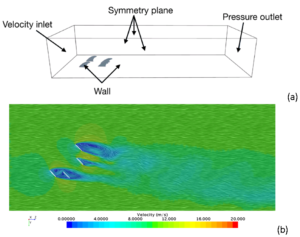HPC User Report from S. Falk (Phoniatrics and Pediatric Audiology)
Numerical study on four fin configurations for surfboards
Computational fluid dynamics (CFD) is used to simulate the governing fluid field around surfboard fins and to calculate their fluid dynamical characteristics. The aim of the project is to evaluate the lift and drag forces for different positions of the fins within the four fin configuration.
Motivation and problem definition
Until now, the surfboard shapers’ experience highly dominates surfboard development in design and construction. Just recently, the shapers started to use milling machines for the board’s fabrication. Nowadays plastics and epoxy compositions are the predominant materials for the fins. Using CFD can not only speed up the development of surfboard and fin design but can also improve the knowledge of the behavior of the complete surfboard system. The basic idea of our studies is to improve CFD models in order to acquire a knowledge base for the fluid dynamical characteristic of the surfboard system.
Methods and codes

The unsteady incompressible Navier-Stokes equations are the governing equations of flow motion around the surfboard fins. Unsteady Reynolds-averaged Navier-Stokes equations simulations were performed using the finite volume method fully integrated into the commercial software package STAR-CCM+ (Siemens). Four fins are inserted into a simplified three-dimensional rectangular fluid volume, with a defined velocity at the inflow. Despite the simplification of the model, the fluid behavior and consequently the high mesh resolution required around the fins (between 2.0 and 2.2 million cells) make the use of high-performance computing (HPC) systems inevitable. Therefore, eight computer nodes of RRZE’s Lima cluster are used to perform the simulations in this study.
Results
The behavior of the lift and drag coefficients shows significant variations between the 24 different fin positions. Placing the fins closer to the outline curve of the surfboard generates higher maximum lift and drag forces. An increased angle of attack results in a decrease of the lift and drag forces, since the rear outside fin comes to lie further in the slipstream of the front outside fin. To get appraisal factors for the surfboards stability and maneuverability the yaw and roll moments were established. Both moments arise simultaneously and are strongly dependent on lift and drag coefficients.
With the mentioned use of HPC resources, the wall time of the URANS simulations ranged up to 33 hours.
Outreach
- Felix Böschen under the supervision of Dr.-Ing. Stefan Kniesburges, Prof. Dr.-Ing. Michael Döllinger and Prof. Dr.-Ing. Stefan Becker: Numerische Analyse der Hydrodynamik eines Drei-Finnen-Surfboard-Setups (Master Thesis).
- Sebastian Falk under the supervision of Dr.-Ing. Stefan Kniesburges, Prof. Dr.-Ing. Michael Döllinger and Prof. Dr.-Ing. Stefan Becker: CFD simulation of four fin configurations and their impact on fluid dynamical characteristics (Master Thesis).
- S. Falk, S. Kniesburges, R. Janka, R. Grosso, S. Becker, M. Semmler, M. Döllinger: Computational hydrodynamics of a typical 3-fin surfboard setup, Journal of Fluids and Structures, 90 (2019) 297-314, DOI:10.1016/j.jfluidstructs.2019.07.006
The project is running since August 2017.
Cooperation
- Prof. Dr. med. Rolf Janka – Department of Radiology at the University Hospital Erlangen: Responsible for the CT Scans of the surfboard and the fins.
- Dr. Roberto Grosso – Computer Graphics Group at the Friedrich-Alexander University Erlangen-Nürnberg (FAU): Responsible for the segmentation and post-processing of the CT data.
Researcher’s Bio and Affiliation
Sebastian Falk obtained his Master degree in Mechanical Engineering at the Friedrich-Alexander University Erlangen-Nürnberg (FAU) from Prof. Dr.-Ing. Stefan Becker (Head of research) at the Institute of Process Machinery and Systems Engineering and is currently a PhD student and scientific assistant under the supervision of Dr.-Ing. Stefan Kniesburges and Prof. Dr.-Ing. Michael Döllinger (Head of research) at the division of Phoniatrics and Pediatric Audiology at the Department of Otorhinolaryngology, Head and Neck Surgery of University Hospital Erlangen and Medical Faculty of FAU.
